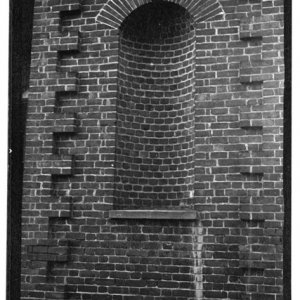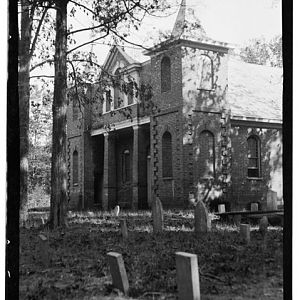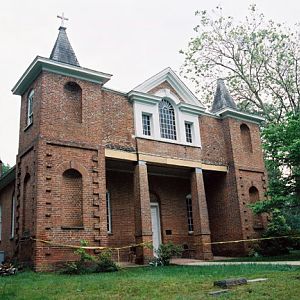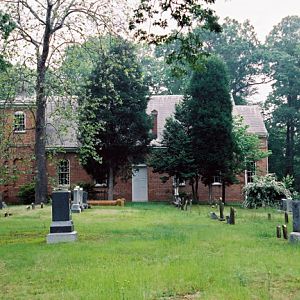You are using an out of date browser. It may not display this or other websites correctly.
You should upgrade or use an alternative browser.
You should upgrade or use an alternative browser.
Saint Andrew's Church
St. Mary's County, Maryland
The architecture of the church is unusual, in that it possesses the unique features of double western towers. These are engaged at either corner of the west front, and between them is an open loggia. This latter feature is covered by the gallery of the church, the west wall of which is supported by lintels on two square brick piers. The body of the church is rectangular with a square projection, forming the chancel at the east end. The interior of the church is divided into nave and aisles by two ranges of fluted Ionic piers. The aisles have flat ceilings and the nave ceiling is a semicircular vault.
The brick work of the church is laid in Flemish bond with a tooled line struck in the center of the joint. It is generally in good condition. No rubbed or gauged dressings are used. In the west face of the lower story of each tower is a niche, elliptical in section, with arched head, which is laid all in headers. The corners of the lower stones of the towers have rusticated brick quoins, which are not beveled, but merely raised beyond the surface of the wall. There are square headed windows in the upper stories of the towers. Each tower is surmounted by a squat spire, of poor and apparently modern design. The brick loggia piers are Doric with a preceptible enttasis.
Above the loggia the wall is pierced by a crude Falladian window. The three sections of this seem to have the original sash, which is fixed, without meeting rails. The muntin is very thin. The shape of the sash openings is unusual in being definitely truncated. The effect of this feature is hurt by modern wood trim. The pediment above it also has poor modern trim. All the main cornice of the church is inappropriate and modern.
The windows on the sides of the church are arranged two on either of the "transept" doors, and one in the side of the chancel. These all have segmental heads. The arch bride of these segmental arches is not ground to a center, the splay being taken, up in the joints. There is a brick key, projecting from the face of the arch. The windows are narrow and while the present staff bead is modern, it is improbable that
---------------------
HISTORICAL REPORT
From the limited search, it does not appear that St. Andrew's Church, in St. Mary's County, Maryland, has any special historical significance. It was built in 1756, and evidently copied from Christ Church at Chaptico, in the same county, whose design is attributed to Christopher Wren and which was apparently built about 1694. (1) Further data regarding St. Andrews is cited below. (2)
(1) Hidgely, H. W., The Old Brick Churches of Maryland, New York, 1894. pp. 53-54.
(2) Other references are:
Andrews, M. P., History, of Maryland, N.Y., 1929.
Croker, M.B., Tales and Traditions of Old St. Mary's n.p. (privately printed) 1934.
Maryland Historical Society, Maryland Historical Magazine, 29 vols., 1906-1934. Indexes.
Scharf, J, T. , History of Maryland, 3 vols., Baltimore, 1879.
Signed,
Stuart Guthbertson
Historical Technician Branch of Historic Sites and Buildings.
---------------------
In 1694 St. Mary's County was divided into two parishes: William and Mary and King and Queen. The former embraced the area below St. Clements Bay, and included a church built about 1642 at J'oplar Hill. At Chaptico a church was built in the same year and another in 1&94 to replace it. The distance between the two was about twenty miles as the crow files.
In 1755 a meeting was held at Leonardtown in the court house and a group including Abraham Barnes, James Tarlton, John Newton, Enoch Abell and Mathew nise proceeded to call a pastor. In 1766 another meeting agreed to build a new church in a place called "Waldrum's Old Field" belonging to Samuel Bellwood. Among those present were Hon. Col. George Hater, Stourtcn Edwards, leter Urguart, Hugh Hopewell, John Abell, Sr., and Philip Clark, Jr., vestry men, also Cuthbert Abell and Mathew Wise, Sr., wardens. The (St. Andrew's) Church was to be 70 x 40 feet, exclusive of chancel and to be built according to Richard Boulton's plans. This group bought two acres of land for X 5 currency from Sain Bellwood. Size of building was described at another meeting as 55 feet long exclusive of chancel by 40 feet wide, both in the clear. These dimensions agree with the building as it stands today. Also, Hugh Hope-well was ordered to pay Benjamin Morgan 15 shillings for surveying land for the church, and William Hussell was to get the deed for the two acres of land.
In 1767 a vestry meeting was held in the new church "in St. Andrew's Parish." Those present were: Rev. Robert Henny, Col. George Plater, Hugh Hopewell, Esq., Feter Ur quart, John Abell, Sr. and Philip Clark, vestrymen. Also: Cuthbert Abell, and Mathew ftise, Sr., wardens.
In 1767 or 1771 the vestry paid 16/10 British Pounds to provide board for John Freich Leinner who was making the reredos.
1676 - St. Mary's State House cost 320,000 pounds of tobacco or perhaps 1500 pounds currency. Size c. 50,000 cu. ft.
1695 - St. Paul's Church (Kent) cost 21,000 pounds of tobacco. Size c. 24,000 cu. ft. (The equivalent of 126 pounds colonial currency.)
1713 - St. Paul's (Second Church) cost 70,000 pounds of tobacco. Size 37,000 cu. ft (The equivalent of 200 pounds Colonial currency.)
1771 - Chase House, Annapolis. Sold for 504 pounds sterling of £491 pounds currency (included value of land.)
1752 - Tobacco worth 1 penny per pound, or 1/3 of its value 100 years earlier.
1765 - St. Andrews Vestry voted 200,000 pounds tobacco for the new building and 5 pounds currency for 2 acres of land. This appears to equal the contemporary sum of 400 pounds Colonial currency. Size 75,000 cu. ft. Approximate cost 2 pence per cu. ft.
The walks were specified to be two bricks (18") above water table and three bricks (37") below. Flagstone aisles and arched ceiling were specified in the contract.
The building, as it stands today, is shown (Approximately) in the attached sheets "A" and "B". The towers with loggia between form a feature at the west end which is unique among American Colonial Churches. The arched nave between columns which support flat aisle ceilings is peculiar to Southern Maryland where it is found in early churches of Catholic as well as of Episcopal communion. Otherwise, the general shape and organization of the design is characteristic of the early Episcopal church of the South. The easterly chancel projection is found only in late 18th Century examples, such as Pompion Hill Church, Berkeley County, S.C. The two doors, north and south are also characteristic of the later colonial type, and it is evident that no pulpit ever graced the north wall. The pew arrangement is undoubtedly original but the lower gallery may have been a later addition at a time when the slave population increased.
The brick work is generally Flemish bond, laid with red-pink brick (8 courses to 25".) The bricks measure about 2-1/2 to 2-3/4 by 4-1/4 to 4-3/8 by 8-3/4.* On the north wall, the base course and four to six courses above the water table are laid headers every 4th course and the bricks are of uniform red color and measure 2-1/8 to 2-1/4by 4 to 3-7/8 by 8 to 8-1/4. This section resembles underpinning or the remnant of an older wall, antedating the present building.
D. H. Smith
February 26, 1936.
* Arches generally are turned with special long bricks, burned or ground to a rough radius, quoins stop in primitive fashion with projection beyond the cornice moldings.
St. Mary's County, Maryland
The architecture of the church is unusual, in that it possesses the unique features of double western towers. These are engaged at either corner of the west front, and between them is an open loggia. This latter feature is covered by the gallery of the church, the west wall of which is supported by lintels on two square brick piers. The body of the church is rectangular with a square projection, forming the chancel at the east end. The interior of the church is divided into nave and aisles by two ranges of fluted Ionic piers. The aisles have flat ceilings and the nave ceiling is a semicircular vault.
The brick work of the church is laid in Flemish bond with a tooled line struck in the center of the joint. It is generally in good condition. No rubbed or gauged dressings are used. In the west face of the lower story of each tower is a niche, elliptical in section, with arched head, which is laid all in headers. The corners of the lower stones of the towers have rusticated brick quoins, which are not beveled, but merely raised beyond the surface of the wall. There are square headed windows in the upper stories of the towers. Each tower is surmounted by a squat spire, of poor and apparently modern design. The brick loggia piers are Doric with a preceptible enttasis.
Above the loggia the wall is pierced by a crude Falladian window. The three sections of this seem to have the original sash, which is fixed, without meeting rails. The muntin is very thin. The shape of the sash openings is unusual in being definitely truncated. The effect of this feature is hurt by modern wood trim. The pediment above it also has poor modern trim. All the main cornice of the church is inappropriate and modern.
The windows on the sides of the church are arranged two on either of the "transept" doors, and one in the side of the chancel. These all have segmental heads. The arch bride of these segmental arches is not ground to a center, the splay being taken, up in the joints. There is a brick key, projecting from the face of the arch. The windows are narrow and while the present staff bead is modern, it is improbable that
---------------------
HISTORICAL REPORT
From the limited search, it does not appear that St. Andrew's Church, in St. Mary's County, Maryland, has any special historical significance. It was built in 1756, and evidently copied from Christ Church at Chaptico, in the same county, whose design is attributed to Christopher Wren and which was apparently built about 1694. (1) Further data regarding St. Andrews is cited below. (2)
(1) Hidgely, H. W., The Old Brick Churches of Maryland, New York, 1894. pp. 53-54.
(2) Other references are:
Andrews, M. P., History, of Maryland, N.Y., 1929.
Croker, M.B., Tales and Traditions of Old St. Mary's n.p. (privately printed) 1934.
Maryland Historical Society, Maryland Historical Magazine, 29 vols., 1906-1934. Indexes.
Scharf, J, T. , History of Maryland, 3 vols., Baltimore, 1879.
Signed,
Stuart Guthbertson
Historical Technician Branch of Historic Sites and Buildings.
---------------------
In 1694 St. Mary's County was divided into two parishes: William and Mary and King and Queen. The former embraced the area below St. Clements Bay, and included a church built about 1642 at J'oplar Hill. At Chaptico a church was built in the same year and another in 1&94 to replace it. The distance between the two was about twenty miles as the crow files.
In 1755 a meeting was held at Leonardtown in the court house and a group including Abraham Barnes, James Tarlton, John Newton, Enoch Abell and Mathew nise proceeded to call a pastor. In 1766 another meeting agreed to build a new church in a place called "Waldrum's Old Field" belonging to Samuel Bellwood. Among those present were Hon. Col. George Hater, Stourtcn Edwards, leter Urguart, Hugh Hopewell, John Abell, Sr., and Philip Clark, Jr., vestry men, also Cuthbert Abell and Mathew Wise, Sr., wardens. The (St. Andrew's) Church was to be 70 x 40 feet, exclusive of chancel and to be built according to Richard Boulton's plans. This group bought two acres of land for X 5 currency from Sain Bellwood. Size of building was described at another meeting as 55 feet long exclusive of chancel by 40 feet wide, both in the clear. These dimensions agree with the building as it stands today. Also, Hugh Hope-well was ordered to pay Benjamin Morgan 15 shillings for surveying land for the church, and William Hussell was to get the deed for the two acres of land.
In 1767 a vestry meeting was held in the new church "in St. Andrew's Parish." Those present were: Rev. Robert Henny, Col. George Plater, Hugh Hopewell, Esq., Feter Ur quart, John Abell, Sr. and Philip Clark, vestrymen. Also: Cuthbert Abell, and Mathew ftise, Sr., wardens.
In 1767 or 1771 the vestry paid 16/10 British Pounds to provide board for John Freich Leinner who was making the reredos.
1676 - St. Mary's State House cost 320,000 pounds of tobacco or perhaps 1500 pounds currency. Size c. 50,000 cu. ft.
1695 - St. Paul's Church (Kent) cost 21,000 pounds of tobacco. Size c. 24,000 cu. ft. (The equivalent of 126 pounds colonial currency.)
1713 - St. Paul's (Second Church) cost 70,000 pounds of tobacco. Size 37,000 cu. ft (The equivalent of 200 pounds Colonial currency.)
1771 - Chase House, Annapolis. Sold for 504 pounds sterling of £491 pounds currency (included value of land.)
1752 - Tobacco worth 1 penny per pound, or 1/3 of its value 100 years earlier.
1765 - St. Andrews Vestry voted 200,000 pounds tobacco for the new building and 5 pounds currency for 2 acres of land. This appears to equal the contemporary sum of 400 pounds Colonial currency. Size 75,000 cu. ft. Approximate cost 2 pence per cu. ft.
The walks were specified to be two bricks (18") above water table and three bricks (37") below. Flagstone aisles and arched ceiling were specified in the contract.
The building, as it stands today, is shown (Approximately) in the attached sheets "A" and "B". The towers with loggia between form a feature at the west end which is unique among American Colonial Churches. The arched nave between columns which support flat aisle ceilings is peculiar to Southern Maryland where it is found in early churches of Catholic as well as of Episcopal communion. Otherwise, the general shape and organization of the design is characteristic of the early Episcopal church of the South. The easterly chancel projection is found only in late 18th Century examples, such as Pompion Hill Church, Berkeley County, S.C. The two doors, north and south are also characteristic of the later colonial type, and it is evident that no pulpit ever graced the north wall. The pew arrangement is undoubtedly original but the lower gallery may have been a later addition at a time when the slave population increased.
The brick work is generally Flemish bond, laid with red-pink brick (8 courses to 25".) The bricks measure about 2-1/2 to 2-3/4 by 4-1/4 to 4-3/8 by 8-3/4.* On the north wall, the base course and four to six courses above the water table are laid headers every 4th course and the bricks are of uniform red color and measure 2-1/8 to 2-1/4by 4 to 3-7/8 by 8 to 8-1/4. This section resembles underpinning or the remnant of an older wall, antedating the present building.
D. H. Smith
February 26, 1936.
* Arches generally are turned with special long bricks, burned or ground to a rough radius, quoins stop in primitive fashion with projection beyond the cornice moldings.





